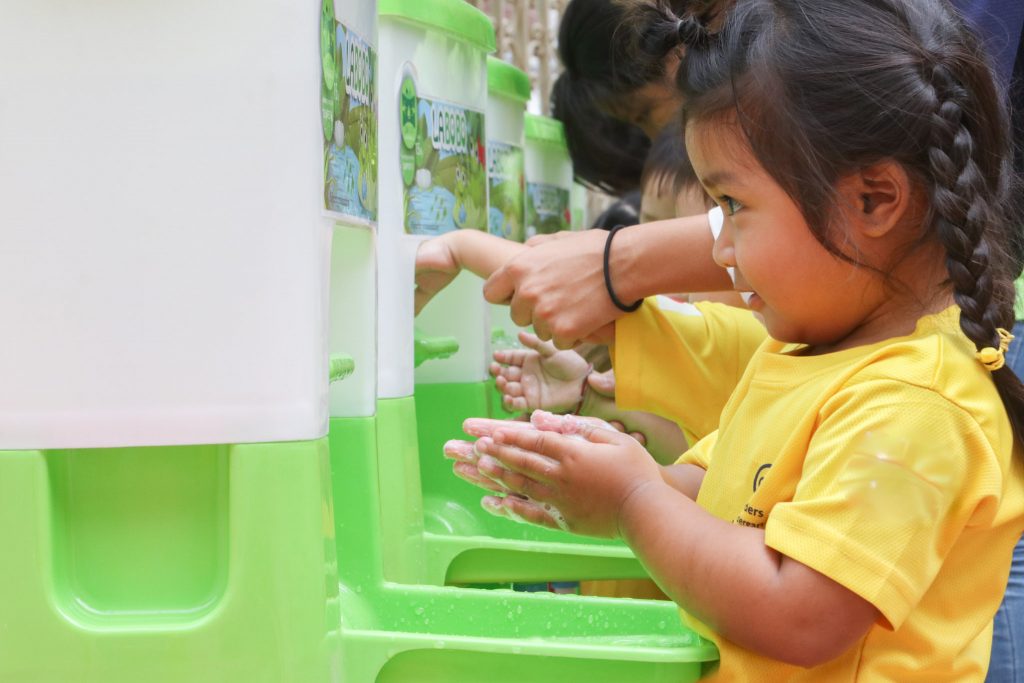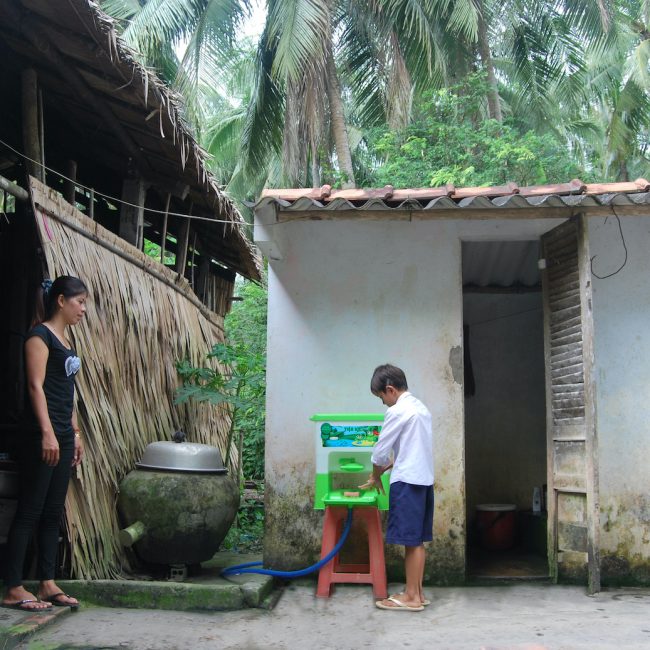3 min read
Handwashing with soap is priority in fighting this pandemic – and the next one. It is even more effective than hand sanitizer[1].
Even before COVID19, handwashing with soap has saved lives. Over 500,000 child deaths each year are due to diarrhoea and acute respiratory infections[2]. Handwashing with soap cuts that number by half[3].
If handwashing with soap is so critical, why are people not washing their hands? Why is it that global handwashing rates are only at 19%[4]? Vietnam at 6%[5]? Bangladesh at 2%[6]?
A 2012 study in Bangladesh found that, despite a high awareness (95%) of critical times to wash hands, less than 10% of respondents were doing so before eating and even fewer before feeding babies.[7]
It might not come as a surprise that people are twice as likely to wash their hands if they have a designated handwashing facility[8]. Roughly 3 billion people – 40% of the world’s population – lack a basic place for handwashing with soap at home[9]. The solution would be simple; people must have handwashing facilities in order to wash their hands more.
There are three ways to increase the number of handwashing facilities:
- Build sinks / handwashing devices
- Give away handwashing sinks
- Design a product people will invest in for clinics, workplaces (including restaurants and schools) and homes.
The first option relies on people building sinks from scrap materials, but the incentive to build a household fixture from upcycled materials is not particularly motivating. Our consumer insights research from the Lower Mekong Delta region revealed that rural households do not want a homemade device assembled with reusable materials, and these homemade devices rarely last. Instead, people were willing to invest in a new product specifically designed for handwashing if the device is attractive and durable.[10]
The second option, providing free or subsidized handwashing stations, has not been rigorously tested for effectiveness, and the cost of implementation would not be reasonable at any meaningful scale.
The third option is to design a product that people want to invest in. Building a local market around essential products like sanitation and hygiene ensures access to and uptake of improved products as they become available.
No matter where donors and investors are on the impact investment spectrum, funding for thoughtful, consumer-centric hygiene products and services can help reduce the public health damage from this pandemic and change the future of safe hygiene. We cannot realistically disperse hand-sanitizer to everyone, wait for a vaccine, and return to “normal”. “Normal” means we have not improved our systems’ ability to prevent the next pandemic. “Normal” is having only 19% of the world’s total population washing their hands properly and 500,000 children dying per year from diarrhea. Let’s immediately invest in a stronger hygiene system.
Further reading and resources:
- What kind of handwashing facilities should we construct? Hygiene Hub, April 2020, https://resources.hygienehub.info/en/articles/3915935-what-kinds-of-handwashing-facilities-should-we-construct
- Ten immediate WASH actions in healthcare facilities for COVID-19 response. Global Handwashing Partnerships, April 2020, https://globalhandwashing.org/wp-content/uploads/2020/04/WASH-in-HCF-Actions-for-COVID-19.pdf
- Water, sanitation, hygiene and waste management guidance for the COVID-19 virus. WHO and UNICEF, April 2020, https://apps.who.int/iris/bitstream/handle/10665/331846/WHO-2019-nCoV-IPC_WASH-2020.3-eng.pdf
About HappyTap Co.
HappyTap Co. is a social business operating in South Asia and Southeast Asia that designs, manufactures, and sells the HappyTap – the first and only portable sink designed to encourage consistent handwashing with soap. Despite being such a simple act, handwashing is the most effective defense against many deadly diseases. During the COVID-19 pandemic, HappyTap CO. is partnering with response organizations to strengthen hygiene infrastructure, e.g. our partnership work in Vietnam. To learn more about HappyTap Co’s response to the COVID-19 pandemic, with the support of international actors such as Grand Challenges Canada, go here.
Contact: Lin Lu,+855 95 509 707, [email protected]
[1]“Show Me the Science – When & How to Use Hand Sanitizer in Community Settings.” (2020) Center for Disease Control and Prevention. https://www.cdc.gov/handwashing/show-me-the-science-hand-sanitizer.html
[2] Diarrhoeal disease: Key Facts. (2017).WHO. https://www.who.int/news-room/fact-sheets/detail/diarrhoeal-disease
[3] “Overview of Hygiene in Lower Income Countries.” (2016) Center for Disease Control and Prevention. https://www.cdc.gov/healthywater/hygiene/ldc/index.html?CDC_AA_refVal=https%3A%2F%2Fwww.cdc.gov%2Fhealthywater%2Fhygiene%2Fldc%2Fdiarrheal_diseases.html
[4] Freeman, Matthew C, et al. (2014) “Hygiene and health: systematic review of handwashing practices worldwide and update of health effects.” Tropical Medicine and International Health. Volume 19, No. 8 pp 906–916. doi:10.1111/tmi.12339
[5] Chase, C., & Do, Q. T. (2012). “Handwashing behavior change at scale: evidence from a randomized evaluation in Vietnam.” World Bank Policy Research Working Paper, (6207).
[6] Icddr,b (2008). “Hand washing Behavior in Rural Bangladesh.” Health and Science Bulletin. Sep;6(3):21-24.
[7] Sifat E Rabbi & Nepal C Dey. (2013). “Exploring the gap between hand washing knowledge and practices in Bangladesh: a cross-sectional comparative study.” BMC Public Health. Volume 13, Article number: 89. https://bmcpublichealth.biomedcentral.com/articles/10.1186/1471-2458-13-89
[8] Wolf, J., et. al. (2019) “Handwashing with soap after potential faecal contact: global, regional and country estimates.” International Journal of Epidemiology. 48(4), 1204–1218, https://doi.org/10.1093/ije/dyy253
[9] Fact Sheet: handwashing with soap, critical in fight against coronavirus, is ‘out of reach’ for billions. (2020) UNICEF. https://www.unicef.org/press-releases/fact-sheet-handwashing-soap-critical-fight-against-coronavirus-out-reach-billions
[10] Nguyen, Nga Kim and Jacqueline Devine. (2012) “Results, Impacts, and Learning from Vietnam.” Global Scaling Up Handwashing Project. https://www.wsp.org/sites/wsp/files/publications/WSP-Vietnam-HWWS-Impacts-Results.pdf




















